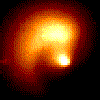

By about the end of April, viewers were able to catch sight of the comet very low in the northwest in early evening hours. As April progresses into May, the comet climbs higher into far-southerners' evening skies. By late May, when their northern counterparts are losing sight of it, Southern Hemisphere watchers will still find the comet fairly high above the horizon well after dusk's end. Although Hale-Bopp will have faded substantially from its peak brightness, a fairly long tail may still be visible.
Thus, there is a possibility that observers below the equator will be treated to a decent display after all. And Southern Hemisphere viewers with telescopes will be well placed to follow the comet's slow recession into the distant outer solar system for the next couple of years.
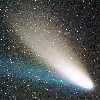 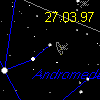 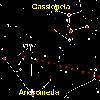 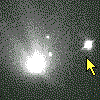 |
Comet Hale-Bopp passed its perihelion
- the orbital point closest to the Sun - early in April 1st, at about 03:19
UT. At that time the distance to the Sun wwas 137 million km and the orbital
speed 44 km/sec. The distance to the Earth was about 202 million km while
the comet was moving away from us at a speed of 13 km/sec. It was located
about 43o from the Sun in the sky and moving at a rate of about
1.7o/day. The next perihelion passage will take place some 2380
years from now, in the late 44th century.
Hale-Bopp comet crossed the Mars orbit on January 8, 1996. The tail was not well visible at this moment because it was pointing away from the Earth (the comet was on the other side of the Sun and the tail pointed away from the Earth). By the end of January, 1997, reached about magnitude 2.5, the tail was about 1.5 degrees long and the coma had a diameter roughly that of the full moon (half a degree). If you haven't heard of the supposed "companion" to Comet Hale-Bopp -also known as the Saturn-Like Object (SLO)-- then consider yourself lucky. Take a look to the article by Stuart J. Goldman, published by Sky & Telescope. |
 |
Sites to visit |
 |
A dramatic and effective way to begin a unit on comets is to make your own comet right in front of the class. The ingredients for a comet are not difficult to find and watching a comet being "constructed" is something the students will remember for a long time. Dennis Schatz has a recipe for a six-inch comet than you will find at The Why Files . |
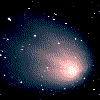 |
Tim Puckett is a worlwide known
astrophotographer. This picture (click on it) was taken thhough his 30
cm Schmidt-Cassegrain telescope (SCT) at f/10 and Axiom AX-7 CCD camera.
You will find more masterpieces like this one in his comets
page.
|
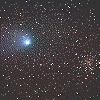 |
Chris Schur owns an excellent page
on astronomy and astrophotography. This view of comet Hale-Bopp besides
cluster NGC6366 is a sample.
|
 Photos
Photos Maps
Maps